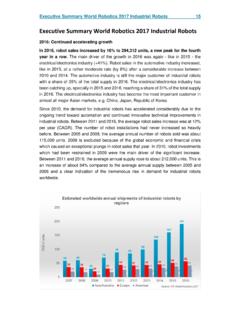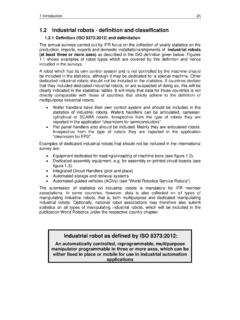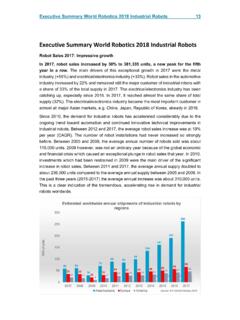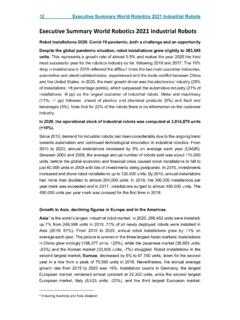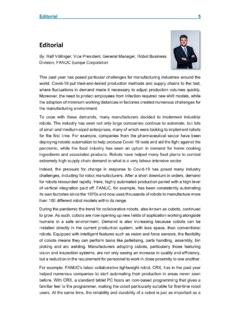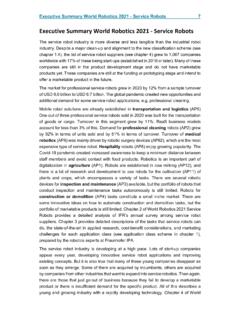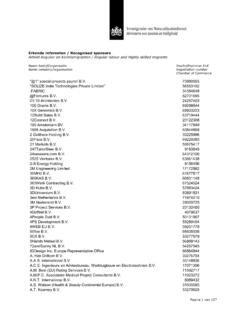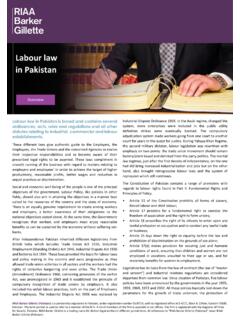Transcription of The Impact of Robots on Productivity, Employment and Jobs
1 The Impact of Robots on Productivity, Employment and Jobs A positioning paper by the international federation of Robotics April 2017 A positioning paper by the international federation of Robotics 1 INTRODUCTION AND PURPOSE OF THIS PAPER Rapid advances in technology have led to a surge of public interest in automation and robotics. As figures from the international federation of Robotics (IFR) show, sales of Robots are increasing year-on-year, with a 15% increase in 2015 over the previous year. The IFR estimates that over million industrial Robots will be at work in 2019, representing an average annual growth rate of 12% between 2016 and 2019 ( international federation of Robotics 2016).
2 Driving the increase in public interest in robotics and automation is both a fascination with the potential of these technologies to change our lives, and a fear of the Impact of automation including robotics on jobs. These fears are tied into broader geo-political and social shifts driven by issues such as trade policy and immigration that, overall, contribute to a sense of insecurity about the Employment prospects of current and future generations. Consequently, many headlines focus on the potential negative outcomes of automation. This risks overshadowing the very real positive contribution of automation and robotics to productivity, competiveness and job creation.
3 In addition, it could undermine discussion and action on the measures that should be taken to enable countries, organizations and individuals to reap the benefits of automation. This paper provides the IFR s opinion on the Impact of automation - specifically of Robots - on productivity, competitiveness and Employment . IFR is not a policy institute. However, this report includes the main conclusions from a variety of experts on appropriate policy responses to ensure ongoing positive outcomes from automation and the ongoing development and uptake of Robots , with which we concur. A Note on Definitions There is no single agreed definition of a robot although all definitions include an outcome of a task that is completed without human intervention.
4 Whilst some definitions require the task to be completed by a physical machine that moves and responds to its environment, other definitions use the term robot in connection with tasks completed by software, without physical embodiment. The IFR supports the international Organization for Standardisation (ISO) definition 8373 of a robot: - An automatically controlled, reprogrammable, multipurpose manipulator programmable in three or more axes, which may be either fixed in place or mobile for use in industrial automation applications. Reprogrammable: whose programmed motions or auxiliary functions may be changed without physical alterations; Multipurpose: capable of being adapted to a different application with physical alterations; Physical alterations: alteration of the mechanical structure or control system except for changes of programming cassettes, ROMs, etc.
5 Axis: direction used to specify the robot motion in a linear or rotary mode - A service robot is a robot that performs useful tasks for humans or equipment excluding industrial automation application. Note: The classification of a robot into industrial robot or service robot is done according to its intended application. - A personal service robot or a service robot for personal use is a service robot used for a non-commercial task, usually by lay persons. Examples are domestic servant robot, automated wheelchair, personal mobility assist robot, and pet exercising robot. - A professional service robot or a service robot for professional use is a service robot used for a commercial task, usually operated by a properly trained operator.
6 Examples are cleaning robot for public places, delivery robot in offices or hospitals, fire-fighting robot, rehabilitation robot and surgery robot in hospitals. In this context an operator is a person designated to start, monitor and stop the intended operation of a robot or a robot system. IFR members manufacture industrial Robots , used in manufacturing, and service Robots , used in a variety of environments both professional and personal to perform a useful task. The Impact of Robots on Employment 2 THE IFR S POSITION IN SUMMARY The IFR believes that: Robots increase productivity and competitiveness.
7 Used effectively, they enable companies to become or remain competitive. This is particularly important for small-to-medium sized (SME) businesses that are the backbone of both developed and developing country economies. It also enables large companies to increase their competitiveness through faster product development and delivery. Increased use of Robots is also enabling companies in high cost countries to reshore , or bring back to their domestic base parts of the supply chain that they have previously outsourced to sources of cheaper labour. Currently, the greatest threat to Employment is not automation but an inability to remain competitive.
8 Increased productivity can lead to increased demand, creating new job opportunities. These spillovers can be seen within an individual organization, along an industry sector s value chain, and in other sectors, particularly services. Automation has led overall to an increase in labour demand and positive Impact on wages. Whilst middle-income / middle-skilled jobs have reduced as a proportion of overall contribution to Employment and earnings leading to fears of increasing income inequality the skills range within the middle-income bracket is large. Robots are driving an increase in demand for workers at the higher-skilled end of the spectrum, with a positive Impact on wages.
9 The issue is how to enable middle-income earners in the lower-income range to upskill or retrain. Robots complement and augment labour: The future will be Robots and humans working together. Robots substitute labour activities but do not replace jobs. Less than 10% of jobs are fully automatable. Increasingly, Robots are used to complement and augment labour activities; the net Impact on jobs and the quality of work is positive. Automation provides the opportunity for humans to focus on higher-skilled, higher-quality and higher-paid tasks. The IFR believes recent calls for the introduction of a robot tax are unwarranted given the proven positive Impact of robotics on Employment and wages.
10 It would deter badly-needed investment in Robots , undermining the competitiveness of companies and states. Governments may need to assess the means of generating revenues to cover social payments due to a large number of structural factors but there is no valid foundation for taxing a capital investment that improves productivity, increases competitiveness, creates more jobs than it replaces, and leads to workers moving up the skills/ income ladder. Governments and companies must focus on providing the right skills to current and future workers to ensure a continuation of the positive Impact of Robots on Employment , job quality and wages.
